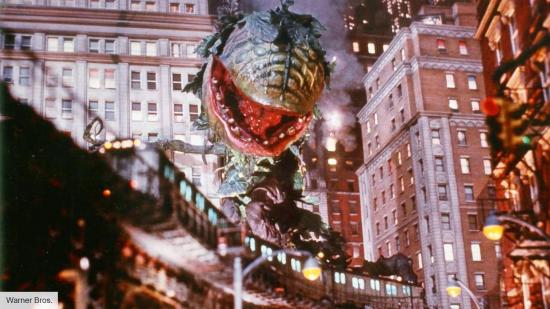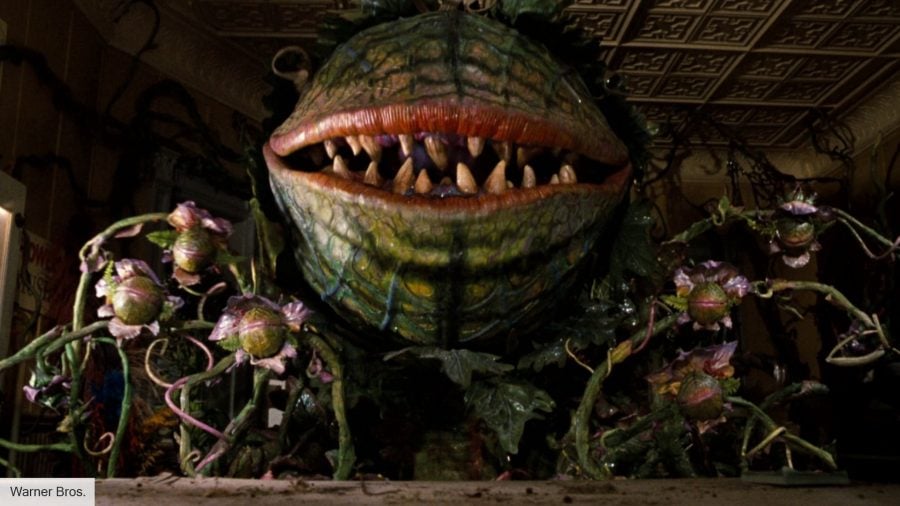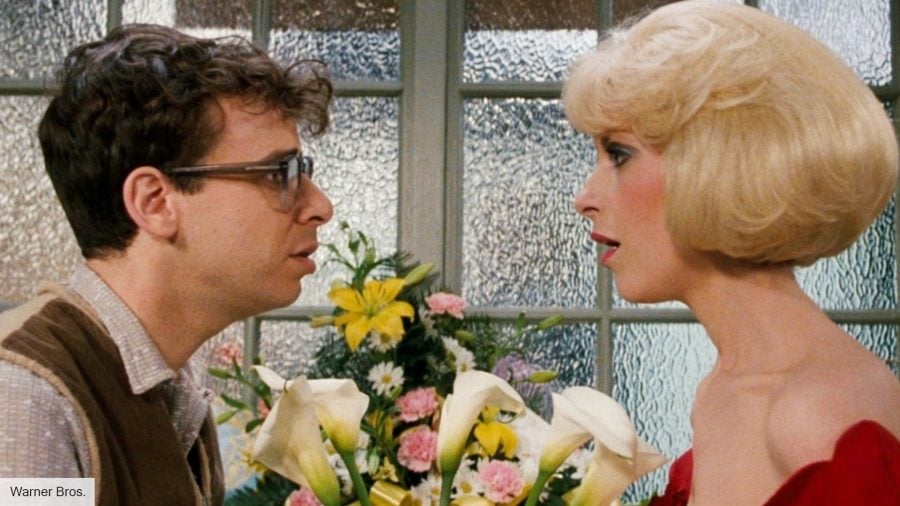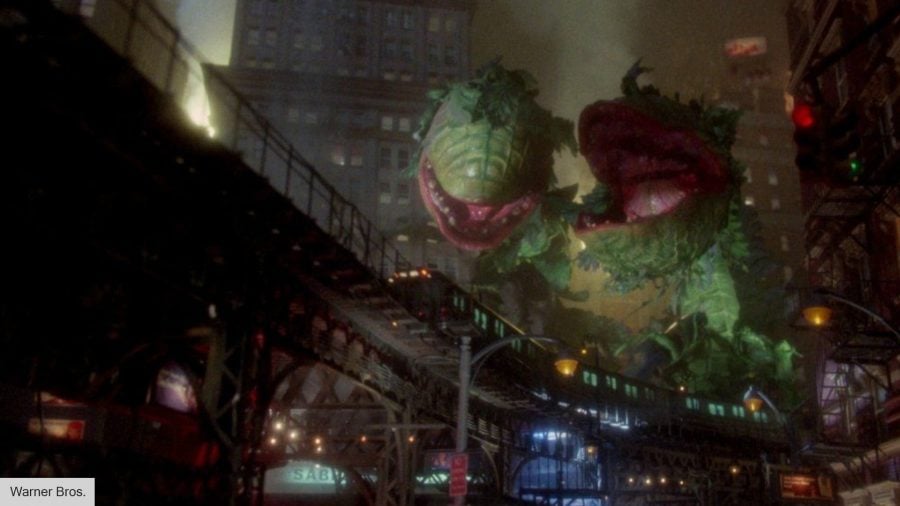Little Shop of Horrors is one of the best musicals of all time, a stunning display of special effects, and has the finest portrayal of a sadistic dentist to ever grace the silver screen. In short, the 1986 monster movie about a bloodthirsty intergalactic plant is an undeniable classic. However, it is also one of those films that has two endings, the director’s cut (also known as the original ending) and the theatrical release. Both endings are wildly different from each other, and well, we have an opinion about which is better. Here is why the original ending of Little Shop of Horrors is the weaker of the two and actually almost ruins the momentum of the rest of the film.
Now many fans will probably already be on edge and vehemently disagree with this opinion, especially those that have a soft spot for the staged musical that featured a similar ending to Frank Oz’s original cut. But, considering how Warner Bros almost didn’t release the film due to the extremely lacklustre audience response at preview screenings for the first ending, it’s safe to say that the director’s cut is something that should at least be investigated. So, before you feed me to a man-eating Venus flytrap from space, please give me a chance to explain and unpack what makes the original ending of Little Shop of Horrors so unsatisfying.
Directed by Frank Oz, Little Shop of Horrors is a cinematic adaptation of the 1982 off-Broadway musical of the same name and Roger Corman’s ‘60s film. Penned by Howard Ashman, the film is set during the 1960s. It follows Seymour (Rick Moranis), a plant enthusiast living on Skid Row who works at Mr Mushnik’s (Vincent Gardenia) run-down flower shop with his co-worker and love interest Audrey (Ellen Greene).
Just when it looks like the store will have to close down due to business being nearly non-existent, Seymour finds a mysterious plant after a Solar eclipse that immediately starts attracting customers. However, all this new found success comes at a price. It turns out that the plant, which Seymour names Audrey 2, needs human blood to survive. Cue some murder and some catchy songs, and Seymour is soon under the control of a carnivorous alien with a big appetite and a charismatic singing voice.

OK, now with that out the way, let’s make like Mr Mushnik and get down to business. As we said before, the director’s cut’s problems lie in its ending. In the original ending of Little Shop of Horrors, Audrey 2 takes a page from Jeff Wayne’s War of the Worlds. That’s right; we are talking about a full-on alien plant invasion.
In the original ending, we see Audrey 2 eat both Seymour and Audrey and then go on to terrorise the world as it uproots from its pot and takes to the streets of Skid Row – and then the rest of the world. The film becomes almost a kaiju monster flick, as we see multiple Audrey 2’s, laying waste to major cities, eating trains whole, knocking down buildings, and basically killing everyone in their sight.
Back in 2015, Frank Oz, who pushed the studio for his original ending, even acknowledged that it just didn’t translate on the big screen as he had hoped for. In an interview with Entertainment Weekly, the filmmaker and puppeteer recalled the disaster that was the first screenings for Little Shop of Horrors that ultimately made him change the script.
“Going back to the beginning, Howard [Ashman] and I were in David Geffen’s office, and we both wanted to retain the original ending, with the plant winning and the key people dying, and David was against that. He said, you can’t do that, but again he knew Howard, and I wanted to, so David supported us. The film was completed two years later, and we went to San Jose for the first preview, and everyone was very excited about it. This was, I think, the most expensive film Warner Bros. had done at that time,” Oz recalled.
“For every musical number, there was applause, they loved it. It was just fantastic… until we killed our two leads. And then the theatre became a refrigerator, an icebox. It was awful, and the cards were just awful. They were saying that they hated us killing them. You have to have a 55 percent ‘recommend’ to really be released, and we got a 13.”
Even when the director, so attached to his mass plant destruction ending, tried another audience in the hope that the first results were just a fluke, he had no luck. Even with a new test audience, the ending still bombed, and Oz was put in a corner. He had to change the end of Little Shop of Horrors or risk a financial box office catastrophe on one of the studio’s most expensive projects.
“It was a complete disaster. After that San Jose screening, I said, ‘Can we just try one more time in L.A. to see if the reaction is different?'” Oz explained. “David supported me, and we did it, and we got exactly the same reaction, like 16 percent or something. Howard and I knew what we had to do: We had to cut that ending and make it a happy ending, or a satisfying ending.”
The happy ending Oz is referring to is the one that shows Seymour electrocuting Audrey 2 and killing the alien plant life in the process. Seymour and Audrey live happily ever after in a white picket fence dream with a small Audrey 2 growing ominously in their garden. It is vastly different to the Broadway play and what you’d expect out of Little Shop of Horrors, but it is still narratively better than the ending that is more in tune with the original source material.
A talent for pain: The best horror movies
After re-watching Oz’s original ending of Little Shop of Horrors, as much as it pains me as a theatre nerd and practical effects lover to admit it, I’ve realised it wasn’t just killing off the leads that made the original ending flop during its test screenings, it was its one-note ending invasion montage that dragged out the story.
Yes, killing the leads of your film is always risky but it’s not a deal-breaker. There are plenty of popular films that kill its main characters that audiences still like and admire today. Think of stories like Thelma and Louise, The Great Gatsby, or Moulin Rouge – they all still worked, happy endings or not and didn’t score so low during their test screenings either, especially not a 13 or 16.
With that in mind, regardless of how likeable Seymour and Audrey may be as characters, we know there is something more behind the audiences’ reaction to Little Shop of Horrors than simply the “they hated us killing [Seymour and Audrey]” statement given by Oz.
What really makes Little Shop of Horrors’ original ending a deal-breaker isn’t the deaths of the leads. It is the fact that the film then goes on for that extra 23 minutes after the hard-hitting murder scene as if Seymour and Audrey weren’t important characters, to begin with, as they are left behind, and their deaths never addressed.
Suddenly Seymour: The best romance movies
Following the said killing moment, there is also a considerable amount of time where there are no new narrative beats in the script, no exciting revelations, and no climax to end the film with a bang. Instead, the movie shows a scene of Audrey 2 invading the world. Yes, it looks cool as hell, but it adds nothing to the story since we already had the scene that showed the plant winning against Seymour and a mini Audrey being made already.
We already know that Audrey 2 won and know what the consequences of that are, so why invest our attention in a long scene showing the alien winning and winning some more? After you get past Oz’s stunning effects and puppet work, the whole scene seems, dare we say, dull since again it adds nothing. There are no characters left who we care about; all the ‘conflict’ of the plant invasion has no stakes because we as viewers haven’t formed a connection with the people we see to be in danger.
In short, the original ending may look great and pay homage to the Broadway play. However, it still comes across as one-note and as if credits should be rolling in front of it since the story of Seymour and Audrey (which at its core is what Little Shop of Horrors is about) is already over.
Narratively the theatrical cut is cleaner, works better story-wise, and is the reason why the musical has become so famous and a personal favourite to many of us here at The Digital Fix today. As we said before, there is a lot to appreciate in Frank Oz’s original vision. However, like any piece of art, outside eyes can help in picking up faults.
Both those initial Little Shop of Horrors’ screenings showed the filmmaker what worked and what didn’t in the film, and at the end of the day, we are happy Oz got that second opinion. Although, after seeing the director’s cut, we know now that Oz could also make a banging Kaiju movie too.



